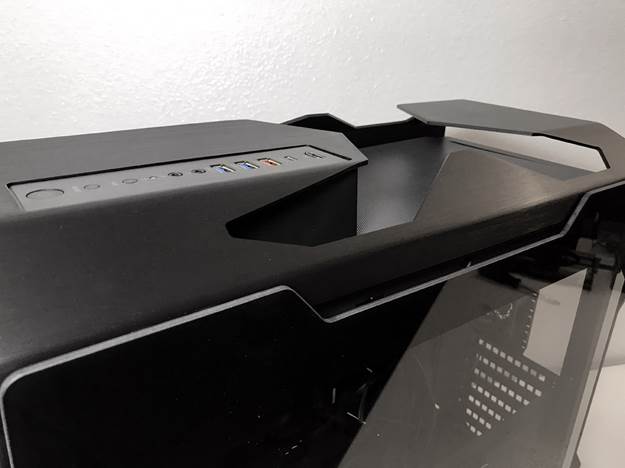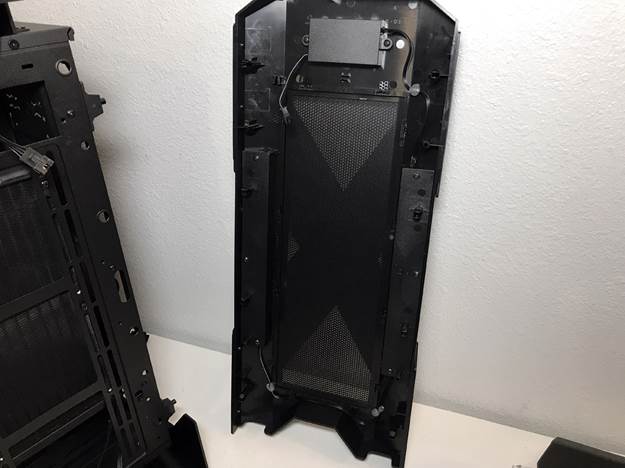Tom's Hardware Verdict
A solid chassis with admirable features the X-Mars Junior is a bit overpriced compared to the competition. Thermal performance could be drastically improved with the addition of a few intake fans, but that in turn adds to the overall cost of the case. If you like the look, styling and features, a price drop of at least $20 (£15.39) could justify spending extra cash to spend on two additional intake fans.
Pros
- +
Solid water cooling support
- +
Quiet operation
- +
Cool retro styling
- +
1USB 3.1 Type-C
- +
VR support
- +
RGB lighting
Cons
- -
Only one fan included
- -
E-ATX motherboards cover the main cable pass-through holes
- -
Poor thermal performance on included fan
- -
TG side panels allow dust to enter system
Why you can trust Tom's Hardware
Features and Specifications
Although the styling is somewhat of a throwback to the late 90's, the X-Mars Junior has all the features a modern high-end PC requires including E-ATX motherboard support, USB 3.1 Type-C, VR support, RGB lighting, brushed aluminum and dual 4mm-thick tempered glass side panels. Sporting a premium price tag of $190 (£146.20), this chassis needs only the builder’s choice of fans to bring it up to performance expectations.
Specifications
| Type | Mid-Tower ATX |
| Motherboard Support | Mini-ITX, Micro-ATX, ATX, E-ATX |
| Dimensions (HxWxD) | 9.37" x 21.06" x 21.07 inches (238 x 535 x 552 mm) |
| Space Above Motherboard | 3 inches (76.2mm) |
| Card Length | 17.01 inches (432mm) |
| CPU Cooler Height | 7.87 inches (200mm) |
| Power Supply Format | ATX |
| Weight | 24.5 lbs (11.11kg) |
| External Bays | ✗ |
| Internal Bays | 2x 3.5" / 3x 2.5” |
| Card Slots | 7x |
| Ports/Jacks | 1x USB 3.1 Type C, 2x USB 3.0, audio/mic jacks |
| Other | RGB control, HDMI for VR |
| Front Fans | ✗ (3x120mm / 2x140mm Max) |
| Rear Fans | 1x120mm |
| Top Fans | ✗ (3x120mm / 2x140mm Max) |
| Bottom Fans | ✗ |
| Side Fans | ✗ |
| Damping | ✗ |
| Warranty | 2 Years |
With large vents, bulging panels and features that often incorporated the name of the chassis into the design, the bold styling of Apexgaming's X-Mars Junior reminds us of gaming cases from decades past. Measuring 238 x 535 x 552mm (WxDxH) and tipping the scales at more than 24 lbs, the X-Mars Junior seems rather large for a mid-tower until we consider that its top panel protrudes roughly three inches out and away from the frame, as does the front panel.
Constructed of steel, aluminum, plastic, and tempered-glass, the X-Mars Junior painted black inside and out. Directly under the brushed aluminum top panel is space for three 120mm or 140mm fans, which are covered by a large removable magnetic filter.





A 2” x 8" (~50x200mm) section of the top panel is home to one USB 3.1 Type-C and two USB 3.0 ports, an HDMI for VR, headphone and microphone jacks, a hard drive activity LED and an RGB, reset and power buttons.
Two large brushed aluminum bars form the shape of a large X across the entire plastic front panel from top to bottom. RGB lighting strips are embedded into the base of the front plastic, and mounting locations for three 120mm or two 140mm fans are behind it.


The full-coverage tinted tempered glass side panels have cut outs at the top, bottom and both sides. The rear of the tempered glass side panels are raised approximately an 1/8th of an inch away from the frame. This, as well as the gaps at the top of the TG side panels, allows for dirt and dust to completely bypass the filtration system. The X-Mars Junior uses rubber-coated locating pins and thumbscrews to secure the panels to the frame.
The rear of the chassis is home to seven card slots, a motherboard I/O area, an opening for a bottom-mounted PSU, and an exhaust-fan mounting location for 120mm fans.
Get Tom's Hardware's best news and in-depth reviews, straight to your inbox.
The bottom of the X-Mars Junior has a power supply dust filter and four rubber-coated feet. The front feet elevate the chassis almost a full inch while the feet in the rear measure just under a half an inch.


Overall, the fan filtration system on the X-Mars Junior does a decent job in terms of its ability to prevent dirt and dust particles from entering your system...with a caveat. When the system has positive air pressure, the filters work as intended. The system as it ships from the factory with a single exhaust fan, negative case pressure allows dust and dirt to be drawn into the system from the rear and upper edge of the tempered glass side panels.
The filter on the top of the case is attached by magnetic seals around its edge. Dual-layer metal mesh built into the front panel acts as a filter for front fans, so that cleaning and maintenance is best done with the entire panel removed. Removing the nylon filter that covers the opening for the power-supply fan from the case's rear often requires moving your entire system to gain access.
Image Credits: Tom's Hardware
MORE: Best Cases
MORE: All Case Content
Current page: Features and Specifications
Next Page Hardware Installation and Test ConfigurationSteven Lynch is a contributor for Tom’s Hardware, primarily covering case reviews and news.




